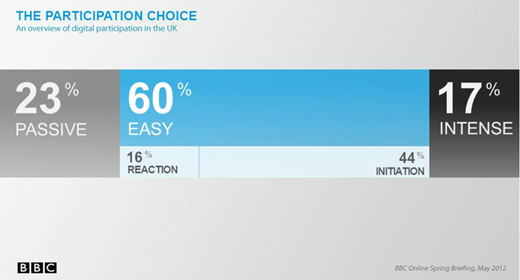
Twice a year the heads of BBC’s digital services brief partners and suppliers on how BBC Online and Red Button will work with them in the months ahead. At the broadcaster’s ‘Spring Briefing‘ today the BBC released research on how the UK population interacts with digital media.
The reserach considers digital media interaction, from sharing links and photos to writing blogs. It turns out that the old 1% rule, which said that more people will lurk in a virtual community than actively participate, is old news and that now, more than 10% are getting online to contribute and interact.
The UK is not a wallflower when it comes to online participation, according to the study, 77% of the online population is now active in some way. But that still means that nearly a quarter of the UK are lurkers.
Ease of use, ubiquity of devices and improved user experience is bound to contribute to the amount of people who get online and take part in activities.
Interestingly the BBC’s research says that lurkers are not necessarily people who are digitally illiterate or unable to gain access. The study results say that 11% of passive web consumers today in the UK are early adopters who choose not to participate. Maybe the sheer volume and noise of life online is putting them off.
The study was led by Holly Goodier, Head of Audiences for BBC Future Media who says on the BBC Internet blog, “Digital participation now is best characterised through the lens of choice. These are the decisions we take about whether, when, with whom and around what, we will participate. Because participation is now much more about who we are, than what we have, or our digital skill.”
The BBC is using this research to create a new model to look at digital activity and is calling it ‘The Participation Choice’.

In the graphic above, ‘initiation’ is distinguished from reaction because it includes activities that are triggers to other people’s participation. So that’s things like uploading photos, starting a discussion and creating groups.
The ‘easy reaction’ group is the closest to passive, they tend to have fewer devices, but they do participate. They respond largely to the activity of others. This includes replying, ‘liking’ and rating, all activities where there’s little effort, exposure or risk.
The Participation Choice is a synthesis of primary and secondary research conducted over the past 18 months. The data published today are all taken from the most recent, large scale survey of 7,500 UK adults – representative of the UK online population.
Social activity and the growth of devices attached to the Internet means that we are changing our habits. It’s not so surprising that the old 1% rule’s time has passed with social media taking up so much room in our lives online.
The BBC has access to a huge audience in order to collect data about user habits. No doubt this research will influence the corporations forthcoming online moves as well as informing others as to how they might harness the latest interaction habits.
Get the TNW newsletter
Get the most important tech news in your inbox each week.



